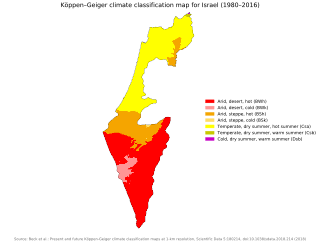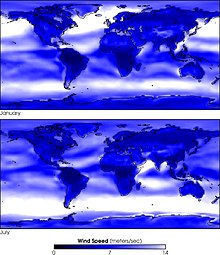
Renewable energy is energy from renewable resources that are naturally replenished on a human timescale. Renewable resources include sunlight, wind, the movement of water, and geothermal heat. Although most renewable energy sources are sustainable, some are not. For example, some biomass sources are considered unsustainable at current rates of exploitation. Renewable energy is often used for electricity generation, heating and cooling. Renewable energy projects are typically large-scale, but they are also suited to rural and remote areas and developing countries, where energy is often crucial in human development.

Resource depletion is the consumption of a resource faster than it can be replenished. Natural resources are commonly divided between renewable resources and non-renewable resources. Use of either of these forms of resources beyond their rate of replacement is considered to be resource depletion. The value of a resource is a direct result of its availability in nature and the cost of extracting the resource, the more a resource is depleted the more the value of the resource increases. There are several types of resource depletion, the most known being: Aquifer depletion, deforestation, mining for fossil fuels and minerals, pollution or contamination of resources, slash-and-burn agricultural practices, soil erosion, and overconsumption, excessive or unnecessary use of resources.

Urban geography is the subdiscipline of geography that derives from a study of cities and urban processes. Urban geographers and urbanists examine various aspects of urban life and the built environment. Scholars, activists, and the public have participated in, studied, and critiqued flows of economic and natural resources, human and non-human bodies, patterns of development and infrastructure, political and institutional activities, governance, decay and renewal, and notions of socio-spatial inclusions, exclusions, and everyday life. Urban geography includes different other fields in geography such as the physical, social, and economic aspects of urban geography. The physical geography of urban environments is essential to understand why a town is placed in a specific area, and how the conditions in the environment play an important role with regards to whether or not the city successfully develops. Social geography examines societal and cultural values, diversity, and other conditions that relate to people in the cities. Economic geography is important to examine the economic and job flow within the urban population. These various aspects involved in studying urban geography are necessary to better understand the layout and planning involved in the development of urban environments worldwide.

Energy is sustainable if it "meets the needs of the present without compromising the ability of future generations to meet their own needs." Most definitions of sustainable energy include considerations of environmental aspects such as greenhouse gas emissions and social and economic aspects such as energy poverty. Renewable energy sources such as wind, hydroelectric power, solar, and geothermal energy are generally far more sustainable than fossil fuel sources. However, some renewable energy projects, such as the clearing of forests to produce biofuels, can cause severe environmental damage.

Climate change mitigation is action to limit climate change. This action either reduces emissions of greenhouse gases or removes those gases from the atmosphere. The recent rise in global temperature is mostly due to emissions from burning fossil fuels such as coal, oil, and natural gas. There are various ways that mitigation can reduce emissions. These are transitioning to sustainable energy sources, conserving energy, and increasing efficiency. It is possible to remove carbon dioxide from the atmosphere. This can be done by enlarging forests, restoring wetlands and using other natural and technical processes. The name for these processes is carbon sequestration. Governments and companies have pledged to reduce emissions to prevent dangerous climate change. These pledges are in line with international negotiations to limit warming.

Energy poverty is lack of access to modern energy services. It refers to the situation of large numbers of people in developing countries and some people in developed countries whose well-being is negatively affected by very low consumption of energy, use of dirty or polluting fuels, and excessive time spent collecting fuel to meet basic needs. Today, 759 million people lack access to consistent electricity and 2.6 billion people use dangerous and inefficient cooking systems. Energy poverty is distinct from fuel poverty, which primarily focuses solely on the issue of affordability.

Fossil fuel phase-out is the gradual reduction of the use and production of fossil fuels to zero, to reduce deaths and illness from air pollution, limit climate change, and strengthen energy independence. It is part of the ongoing renewable energy transition, but is being hindered by fossil fuel subsidies.

100% renewable energy is the goal of the use renewable resources for all energy. 100% renewable energy for electricity, heating, cooling and transport is motivated by climate change, pollution and other environmental issues, as well as economic and energy security concerns. Shifting the total global primary energy supply to renewable sources requires a transition of the energy system, since most of today's energy is derived from non-renewable fossil fuels.

Micro-sustainability is the portion of sustainability centered around small scale environmental measures that ultimately affect the environment through a larger cumulative impact. Micro-sustainability centers on individual efforts, behavior modification, education and creating attitudinal changes, which result in an environmentally conscious individual. Micro-sustainability encourages sustainable changes through "change agents"—individuals who foster positive environmental action locally and inside their sphere of influence. Examples of micro-sustainability include recycling, power saving by turning off unused lights, programming thermostats for efficient use of energy, reducing water usage, changing commuting habits to use less fossil fuels or modifying buying habits to reduce consumption and waste. The emphasis of micro-sustainability is on an individual's actions, rather than organizational or institutional practices at the systemic level. These small local level actions have immediate community benefits if undertaken on a widespread scale and if imitated, they can have a cumulative broad impact.
The water, energy and food security nexus according to the Food And Agriculture Organisation of the United Nations (FAO), means that water security, energy security and food security are very much linked to one another, meaning that the actions in any one particular area often can have effects in one or both of the other areas.

An energy transition is a significant structural change in an energy system regarding supply and consumption. Currently, a transition to sustainable energy is underway to limit climate change. It is also called renewable energy transition. The current transition is driven by a recognition that global greenhouse-gas emissions must be drastically reduced. This process involves phasing-down fossil fuels and re-developing whole systems to operate on low carbon electricity. A previous energy transition took place during the industrial revolution and involved an energy transition from wood and other biomass to coal, followed by oil and most recently natural gas.

Co-benefits of climate change mitigation are the benefits related to mitigation measures which reduce greenhouse gas emissions or enhance carbon sinks.
The desert-covered Kingdom of Saudi Arabia is the geographically largest country in the Middle East. Moreover, it accounts for 65% of the overall population of the GCC countries and 42% of its GDP. Saudi Arabia does not have a strong history in environmentalism. Thus, as the number of population increases and the industrial activity grows, environmental issues pose a real challenge to the country.
Pro-environmental behaviour is behaviour that a person consciously chooses in order to minimize the negative impact of their actions on the environment. Barriers to pro-environmental behaviour are the numerous factors that hinder individuals when they try to adjust their behaviours toward living more sustainable lifestyles. Generally, these barriers can be separated into larger categories: psychological, social/cultural, financial and structural. Psychological barriers are considered internal, where an individual's knowledge, beliefs and thoughts affect their behaviour. Social and cultural barriers are contextual, where an individual's behaviour is affected by their surroundings. Financial barriers are simply a lack of funds to move toward more sustainable behaviour. Structural barriers are external and often impossible for an individual to control, such as lack of governmental action, or locality of residence that promotes car use as opposed to public transit.

Climate change in the Middle East and North Africa (MENA) refers to changes in the climate of the MENA region and the subsequent response, adaption and mitigation strategies of countries in the region. In 2018, the MENA region emitted 3.2 billion tonnes of carbon dioxide and produced 8.7% of global greenhouse gas emissions (GHG) despite making up only 6% of the global population. These emissions are mostly from the energy sector, an integral component of many Middle Eastern and North African economies due to the extensive oil and natural gas reserves that are found within the region. The region of Middle East is one of the most vulnerable to climate change. The impacts include increase in drought conditions, aridity, heatwaves and sea level rise.

Climate change in South Africa is leading to increased temperatures and rainfall variability. Evidence shows that extreme weather events are becoming more prominent due to climate change. This is a critical concern for South Africans as climate change will affect the overall status and wellbeing of the country, for example with regards to water resources. Just like many other parts of the world, climate research showed that the real challenge in South Africa was more related to environmental issues rather than developmental ones. The most severe effect will be targeting the water supply, which has huge effects on the agriculture sector. Speedy environmental changes are resulting in clear effects on the community and environmental level in different ways and aspects, starting with air quality, to temperature and weather patterns, reaching out to food security and disease burden.

Climate change and cities are deeply connected. Cities are one of the greatest contributors and likely best opportunities for addressing climate change. Cities are also one of the most vulnerable parts of the human society to the effects of climate change, and likely one of the most important solutions for reducing the environmental impact of humans. More than half of the world's population is in cities, consuming a large portion of food and goods produced outside of cities. The increase of urban population growth is one of the main factors in air-quality problems. In the year 2016, 31 mega-cities reported having at least 10 million in their population, 8 of which surpassed 20 million people. However, secondary cities - small to medium size cities are rapidly increasing in number and are some of the fastest growing urbanizing areas in the world further contributing to climate change impacts. The UN projects that 68% of the world population will live in urban areas by 2050. Hence, cities have a significant influence on construction and transportation—two of the key contributors to global warming emissions. Moreover, because of processes that create climate conflict and climate refugees, city areas are expected to grow during the next several decades, stressing infrastructure and concentrating more impoverished peoples in cities.
Xuemei Bai (白雪梅) is a professor for Urban Environment and Human Ecology at the Australian National University. She was the winner of the 2018 Volvo Environmental Prize, and is an elected fellow of the Academy of the Social Sciences in Australia.

The climate in Texas is changing partially due to global warming and rising trends in greenhouse gas emissions. As of 2016, most area of Texas had already warmed by 1.5 °F (0.83 °C) since the previous century because of greenhouse gas emissions by the United States and other countries. Texas is expected to experience a wide range of environmental impacts from climate change in the United States, including rising sea levels, more frequent extreme weather events, and increasing pressure on water resources.

Israel, like many other countries in the Middle East and North Africa, experience adverse effects from climate change. Annual and mean temperatures are increasing in Israel, with mean temperature expected to increase between 1.6 and 1.8 °C by 2100. There is a reduction in annual precipitation and delayed winter rains. Israel is already experiencing droughts and water shortages. Heatwaves are other natural hazards expected to increase with climate change.
















